Finding a Great Dog Deshedding Tool
Dog Deshedding Tool, A Sponsored Article written by Janice Jones
|Last Updated January 29, 2020
Do you have one of those dog breeds that sheds heavily either year-round or seasonal? If you’re a new parent to a fur baby, you will know very soon after bringing that adorable puppy home for the first time that your free time is being consumed by a vacuum cleaner.
If you’re a seasoned parent, maybe you’ve reached the tipping point and need to do something about all that dog hair.
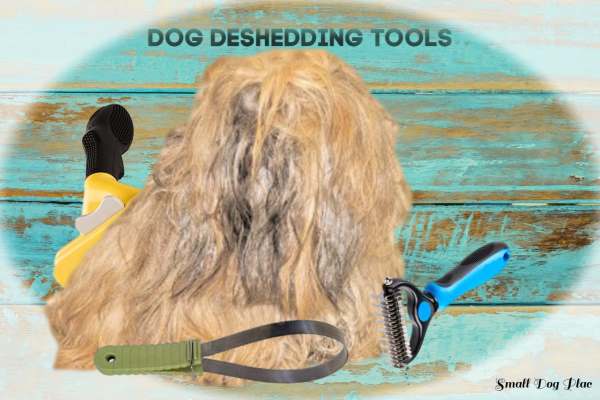 Dog Deshedding Tool
Dog Deshedding ToolI feel your pain because I too was there. There’s nothing worse than hair floating around and landing in your latte. I love dogs but I hate hair, especially when those hairs start to fall in my nose, my eyes and on my tongue. Yuck.
Finding dog hair in my mouth was my tipping point and that is when I went on a search for deshedding tools.
Finding the perfect de-shedding tool for dogs can seem impossible. In a recent Google Search, I came upon more than 50 deshedding tools on one site alone. That didn’t include the numerous brands of deshedding shampoos, gloves, and traditional dog brushes that also double as deshedding tools.
With so many products on the market today, finding one that works well on your dog can be daunting. Just the sheer number of tools available screams one thing:
We love our dogs, but we’re not quite so fond of all that hair that floats around our homes, covering our furniture and settling on our floor.
For those of us who have allergies to hair and dander, reducing the amount of dog hair circulating us is critical to our physical health. You can try to minimize the shedding, but in the end, you will want a deshedding tool.
What is a Dog Deshedding Tool?
Deshedding tools are designed to remove excess hair with the hope that less loose hair on the dog means less shedding into the environment.
Beyond that, deshedding tools come in different sizes, use different technologies and materials and different ergonomic shapes for a secure grip.
No tool can remove 100% of the excess hair, but many come close. All dogs shed, to some extent, even the so-called hypoallergenic breeds.
Some breeds shed year-round, and others are seasonal shedders. Dog breeds such as the American Eskimo, Cardigan and Pembroke Welsh Corgis, Miniature American Shepherds, and Beagles are all moderately heavy shedders that would benefit from a deshedding tool.
But since all dogs do shed, a quality deshedding tool should be in everyone’s grooming toolbox.
Brushing a dog using a bristle, pin, or slicker brush (depending on the coat type) can remove quite a bit of the loose dead hair. Combing can also help.
Some breeds, however, need a little extra help when it comes to removing hair. Sometimes, it’s just easier to use a deshedding tool.
What to Look for in a Dog Deshedding Tool?
Price of the Dog Deshedding Tool
You know the old saying, “You get what you pay for,” but don’t get fooled into thinking you must buy the most expensive tool on the market. Better quality tools will cost more, but the most expensive one on the market may not be the best. Instead, look for quality construction and the features listed below.
Presence of a Fur Ejector Button
Since removing hair is your goal, you will want to make that the most natural part of the job. A tool that holds the fur or hair in place until you are ready to release it is a bonus.
You can use a regular pin brush or comb to remove undercoat and loose hair, but then you must remove the hair from the brush, adding a step to your job. A release button that gets rid of the hair all at once will save you time.
Hand Comfort (Ergonomically)
The tool that feels comfortable in your hand will make the job go faster, but it is even more critical if you have several dogs. You don’t want to walk away from the job with cramped, painful hands. The tool you choose must feel comfortable.
Will the Dog Deshedding Tool Work on All of Your Dogs?
If you only have one dog, your choice of tools will be simple. If you live in a multi-dog household, you will need a tool that will work for all of your dogs unless your pockets are deep and you’d prefer each dog had their own tool. If you live with cats and other animals such as horses, you need something that is designed for many different species.
Stainless Steel Comb Teeth
Most better-quality tools will use stainless steel teeth, but this is important because lower quality tools will have teeth made of inferior materials that could rust. Rusted out tools are useless and will need to be replaced.
A Dog Deshedding Tool Should Be Gentle on Skin
Removing excess and dead hairs should not be painful for your dog. Instead, the entire process should be fun and enjoyable and certainly comfortable. Dogs love massage, and any deshedding session should feel like an excellent massage to your dog.
Add on Features of Dog Deshedding Tools
Some shedding tools provide all these basics plus something else that sets them apart from the rest of the pack. An attachment that connects to a vacuum is one example of a bonus.
The King Komb by King Kanine
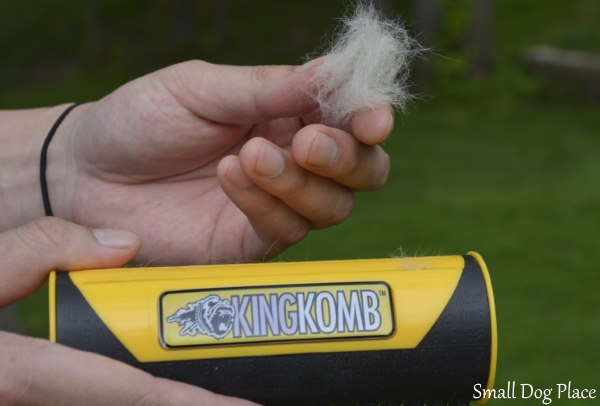 Dog Deshedding Tool: King Komb
Dog Deshedding Tool: King KombThe King Komb deshedding comb for dogs is actually a combo comb and rubble bristle brush, just another one of those bonuses I mentioned above. The King Komb produced by King Kanine is an example of this type of design.
It has three rows of rubber bristles for a total of 51 rubberized bristles that provide a comfortable massage. You can use this portion of the tool dry or provide additional dermal stimulation during a therapeutic bath.
King Komb Product Review
I recently had the chance to try out the King Komb on my dogs and was pleasantly surprised. I have one dog with Cushing’s Disease, which, as you know, can also cause dermatological problems.
We used her current therapeutic shampoo along with the rubberized bristles to give her skin a good massage. Since she is a bulldog, she also tends to shed seasonally, so once her hair was dry, we used the other side of the tool to remove any loose hair and dander.
Her hair was clean, glossy, and healthy, a big plus for a dog with Cushing’s.
Product Description
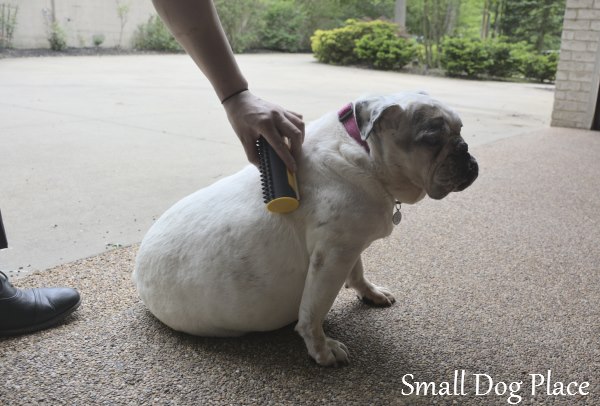 A Dog Deshedding tool, King Komb is being used to reduce the amount of shedding of this English Bulldog.
A Dog Deshedding tool, King Komb is being used to reduce the amount of shedding of this English Bulldog.The King Komb comes in two sizes; the bigger product is for medium and large dogs, and the smaller Deshedding tool works best on small breed dogs and cats. Both work the same, the only difference is in the size of the animal.
I used the tool on my small long-haired dogs to remove undercoat and some loose topcoat hairs. When brushing or combing long-haired dogs, you can end up with a pile of hair embedded in the comb and brush. This tool eliminated that problem.
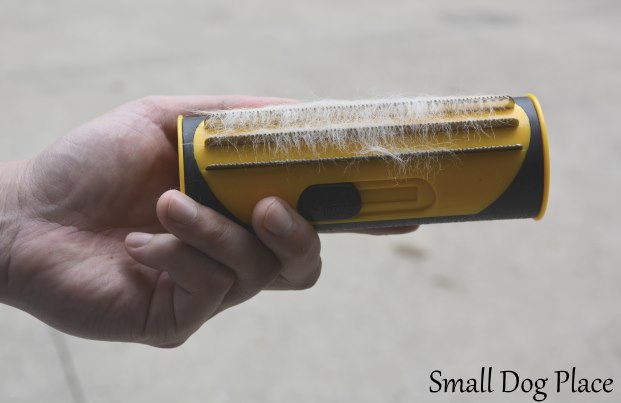 It is easy to collect dog hair on this type of dog shedding tool.
It is easy to collect dog hair on this type of dog shedding tool.If you do use this tool on a long-haired dog, I would recommend removing any mats before running the comb portion through your dog’s hair. It is not meant to remove mats and tangles because the teeth on the three rows of deshedding comb are finely spaced similarly to that of a flea comb. Doing so might cause some discomfort to your dog.
The round shape was unique in that it fits perfectly in my hand while allowing me to de-shed without putting undue pressure on the tool. When using some deshedding tools that have handles, it is easy to press too hard and cut the dog. The round shape of the King Komb makes pushing too hard impossible.
What I Like About the King Komb
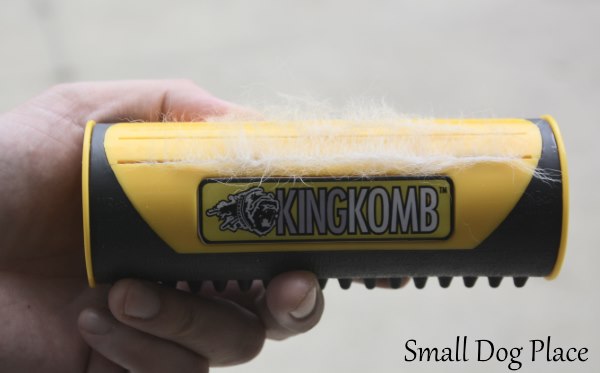 The stainless steel combs are now retracted on the King Komb dog deshedding tool, showing the hair that has accumulated on the side.
The stainless steel combs are now retracted on the King Komb dog deshedding tool, showing the hair that has accumulated on the side.- Round shape that fits in my hand (ergonomic)
- Comfortable, rubberized bristles that provide a deep massage that my dogs love
- Three rows of stainless-steel teeth that grab and remove dead hair
- A retractable button that removes hair immediately from the teeth and slides quickly away from the tool making cleanup a breeze
- Worked equally well on my short haired bulldog as well as my long-haired, Shih Tzu
- It also removed a bit of excess dirt from one of the dog’s coat, which meant I didn’t need to bathe that dog.
This product received high ratings on Amazon, and there were many recommendations for using it not only on your dog but your cat or even your horse. Just the fact that the product is sold at an alpaca farm suggests even more species that would benefit from the product.
Few grooming products work equally well on such a wide range of species.
The King Komb is certainly, a money-saver for horse-lovers that also have dogs and cats. I don't know of any other products on the market that work equally well on such a wide array of species.
Would I Recommend King Komb?
I would recommend you check this tool out if you need a deshedding tool that also functions to give a deep skin massage. It is not meant to replace dog combs and brushes, but as a stand-alone product, it is well worth the money. For anyone with a dog that sheds heavily, this is the way to go.
Where to Purchase the King Komb?
King Kanine products are available both on and offline. You can go to their website and enter your location to find an offline store. You can also purchase directly from King Kanine and Amazon also offers their products.
Recommended for Medium and Large Dogs
Recommended for Small Dogs
Sponsored Post
About Janice (author and voice behind this site)
Having lived with dogs and cats most of her life, Janice served as a veterinary technician for ten years in Maryland and twelve years as a Shih Tzu dog breeder in Ohio.
Her education includes undergraduate degrees in Psychology with a minor in biology, Early Childhood Education, and Nursing, and a master's in Mental Health Counseling.
She is a lifelong learner, a dog lover, and passionate about the welfare of animals. Her favorite breed for over 50 years has been the Shih Tzu, but she has also lived with Poodles, Maltese, Yorkshire Terriers, Beagles, English Bulldogs, Carin Terriers, and a Cocker Spaniel.
When not writing, reading, and researching dog-related topics, she likes to spend time with her eight Shih Tzu dogs, husband, and family, as well as knitting and crocheting. She is also the voice behind Miracle Shih Tzu and Smart-Knit-Crocheting
Does This Article Deserve Your Thumbs Up?
We always appreciate your support and encouragement. Your thumbs up means so much to us. Please like this article.
If you find this page or any page on Small Dog Place Helpful, or useful in anyway, I'd love it if you would click the small heart found on the bottom right of each page.
You can also share or bookmark this page -- just click on the:

Free Monthly Newsletter
Sign Up for Our Free Newsletter and get our Free Gift to You.
my E-book, The Top 10 Mistakes People Make When Choosing a Dog (and how to avoid them)

